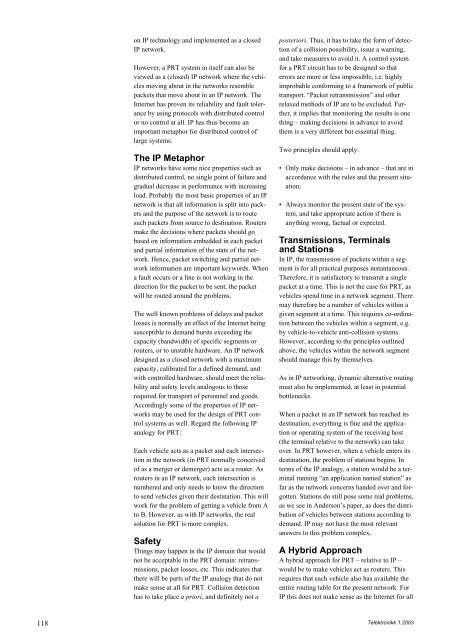Intelligent Transport Systems - Telenor
Intelligent Transport Systems - Telenor
Intelligent Transport Systems - Telenor
Create successful ePaper yourself
Turn your PDF publications into a flip-book with our unique Google optimized e-Paper software.
118<br />
on IP technology and implemented as a closed<br />
IP network.<br />
However, a PRT system in itself can also be<br />
viewed as a (closed) IP network where the vehicles<br />
moving about in the networks resemble<br />
packets that move about in an IP network. The<br />
Internet has proven its reliability and fault tolerance<br />
by using protocols with distributed control<br />
or no control at all. IP has thus become an<br />
important metaphor for distributed control of<br />
large systems.<br />
The IP Metaphor<br />
IP networks have some nice properties such as<br />
distributed control, no single point of failure and<br />
gradual decrease in performance with increasing<br />
load. Probably the most basic properties of an IP<br />
network is that all information is split into packets<br />
and the purpose of the network is to route<br />
such packets from source to destination. Routers<br />
make the decisions where packets should go<br />
based on information embedded in each packet<br />
and partial information of the state of the network.<br />
Hence, packet switching and partial network<br />
information are important keywords. When<br />
a fault occurs or a line is not working in the<br />
direction for the packet to be sent, the packet<br />
will be routed around the problems.<br />
The well known problems of delays and packet<br />
losses is normally an effect of the Internet being<br />
susceptible to demand bursts exceeding the<br />
capacity (bandwidth) of specific segments or<br />
routers, or to unstable hardware. An IP network<br />
designed as a closed network with a maximum<br />
capacity, calibrated for a defined demand, and<br />
with controlled hardware, should meet the reliability<br />
and safety levels analogous to those<br />
required for transport of personnel and goods.<br />
Accordingly some of the properties of IP networks<br />
may be used for the design of PRT control<br />
systems as well. Regard the following IP<br />
analogy for PRT:<br />
Each vehicle acts as a packet and each intersection<br />
in the network (in PRT normally conceived<br />
of as a merger or demerger) acts as a router. As<br />
routers in an IP network, each intersection is<br />
numbered and only needs to know the direction<br />
to send vehicles given their destination. This will<br />
work for the problem of getting a vehicle from A<br />
to B. However, as with IP networks, the real<br />
solution for PRT is more complex.<br />
Safety<br />
Things may happen in the IP domain that would<br />
not be acceptable in the PRT domain: retransmissions,<br />
packet losses, etc. This indicates that<br />
there will be parts of the IP analogy that do not<br />
make sense at all for PRT. Collision detection<br />
has to take place a priori, and definitely not a<br />
posteriori. Thus, it has to take the form of detection<br />
of a collision possibility, issue a warning,<br />
and take measures to avoid it. A control system<br />
for a PRT circuit has to be designed so that<br />
errors are more or less impossible, i.e. highly<br />
improbable conforming to a framework of public<br />
transport. “Packet retransmission” and other<br />
relaxed methods of IP are to be excluded. Further,<br />
it implies that monitoring the results is one<br />
thing – making decisions in advance to avoid<br />
them is a very different but essential thing.<br />
Two principles should apply:<br />
• Only make decisions – in advance – that are in<br />
accordance with the rules and the present situation;<br />
• Always monitor the present state of the system,<br />
and take appropriate action if there is<br />
anything wrong, factual or expected.<br />
Transmissions, Terminals<br />
and Stations<br />
In IP, the transmission of packets within a segment<br />
is for all practical purposes instantaneous.<br />
Therefore, it is satisfactory to transmit a single<br />
packet at a time. This is not the case for PRT, as<br />
vehicles spend time in a network segment. There<br />
may therefore be a number of vehicles within a<br />
given segment at a time. This requires co-ordination<br />
between the vehicles within a segment, e.g.<br />
by vehicle-to-vehicle anti-collision systems.<br />
However, according to the principles outlined<br />
above, the vehicles within the network segment<br />
should manage this by themselves.<br />
As in IP networking, dynamic alternative routing<br />
must also be implemented, at least in potential<br />
bottlenecks.<br />
When a packet in an IP network has reached its<br />
destination, everything is fine and the application<br />
or operating system of the receiving host<br />
(the terminal relative to the network) can take<br />
over. In PRT however, when a vehicle enters its<br />
destination, the problem of stations begins. In<br />
terms of the IP analogy, a station would be a terminal<br />
running “an application named station” as<br />
far as the network concerns handed over and forgotten.<br />
Stations do still pose some real problems,<br />
as we see in Anderson’s paper, as does the distribution<br />
of vehicles between stations according to<br />
demand. IP may not have the most relevant<br />
answers to this problem complex.<br />
A Hybrid Approach<br />
A hybrid approach for PRT – relative to IP –<br />
would be to make vehicles act as routers. This<br />
requires that each vehicle also has available the<br />
entire routing table for the present network. For<br />
IP this does not make sense as the Internet for all<br />
Telektronikk 1.2003
















